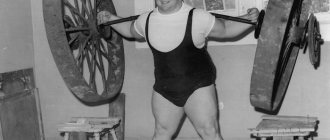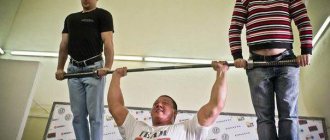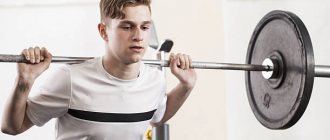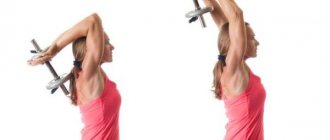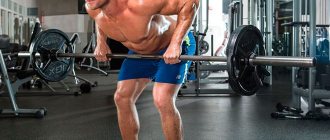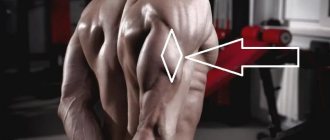Weightlifting is a strength sport that is based on lifting weights. Weightlifting competitions today include two exercises - the snatch and the clean and jerk.
In weightlifting, two types of sports equipment are most often used:
rod (German stange - “rod, rod”), which is a collapsible structure consisting of a bar, at the ends of which there are special bushings for securing the load, which is disks of various weights, and a lock that secures the load;
a (sports) weight, most often having a spherical shape and a special handle for gripping (if the weight is used as part of the design of exercise equipment, it may have a different shape and be equipped with hooks, gripping holes, etc.). There are solid and collapsible weights. The weight of these sports equipment varies from 4 to 56 kg. In kettlebell lifting, they mainly use solid cast iron kettlebells, the weight of which is 16, 24 or 32 kg.
At all times, people with developed muscles, who demonstrated miracles of physical strength, enjoyed the respect and love of their fellow tribesmen. After all, a strong person can handle any job, and a fight is not scary, and in battle, power and hardening are simply necessary. Perhaps this is why exercises with weights, allowing you to gain strength and endurance, have been known since ancient times.
For example, in Ancient Greece, informal weightlifting competitions were often organized. The competitors had to throw a roughly hewn cone-shaped stone back over their heads with both hands. The weight of such stones was more than 100 kg; on one of them, weighing 143.5 kg, there is an inscription that the athlete Bibon (IV century BC) threw it over his head with one hand. Nowadays, an exercise that once served only for training has turned into one of the most famous and spectacular sports.
The first official weightlifting competitions were held in the United States in 1860, and already in 1896 this sport was included in the program of the Olympic Games. However, despite the fact that weightlifting is widespread, many questions arise: is it dangerous for health? Where to begin? How to structure your workouts? Can women do weightlifting? We will try to give answers to these questions, simultaneously debunking the most well-known myths about this sport.
People who decide to take up weightlifting need to immediately master working with a barbell
It is by following this rule that many beginners, who do not consider it necessary to seek advice from an experienced trainer, harm their health. It should be remembered that during the first two to three months it is best to focus on general physical development, alternating a variety of exercises with dumbbells, various machines and a light barbell. At the same time, you need to try not to overwork yourself, explore the capabilities of your own body, strengthen your back muscles, ligaments, and gain strength. Only after this can you begin basic strength training, best under the guidance of a specialist.
Snatch
Three judges decide whether each approach was successful. They find fault with the athletes’ technique and equipment. I remind you that you cannot press the barbell by force - there must be release
from the weight, a fraction of a second of free flight of the barbell upward. A weightlifter is very similar to a juggler - his task is to throw the barbell and take a place under it while the barbell flies upward.
The judges are ready, the competition begins:
There are three judges; in controversial cases, decisions are made by a majority vote.
The essence of the “snatch” exercise is simple: you need to lift the barbell from the platform and sit under it at the moment of flight. Then stand with the barbell at full height and fix the barbell in this position.
The athlete adjusts and takes the starting position (the weight of the bar in the photo is 130 kilograms):
He pulls it out and sits down:
He gets up, the approach is counted:
Weightlifting is primarily about working on perfect technique. Think for yourself - the barbell should fly along an ideal trajectory; at the slightest deviation, the weightlifter will drop the projectile forward or backward.
The first thing we were taught during TA classes was to jump out from under a barbell falling from different positions =)
This is why I don’t have photos of Ilya’s performance - I shot a video with a separate camera so that they could watch the performance with the coach and work on mistakes for each approach.
Before Ilya’s performance, one of the athletes suffered his first serious failure – the so-called “steering wheel”. The weightlifter failed a single approach in the snatch and finished the competition with a zero result. All the preparation, all the effort and the trip - all in vain:
Ilya also almost failed, but on the third attempt he managed to lift the weight of 135 kg.
After him came more prepared athletes. The judges are seriously worried:
Please note that I am not saying that athletes are “stronger”. They are more prepared; strength and preparation are radically different things.
All my experience says that to successfully perform at national-level competitions, you need to combine all three conditions: genetic predisposition, powerful pharmacological support and an inhuman amount of work over many years.
While the leaders are finishing the snatch competition, Ilya begins to warm up the clean and jerk with light weights:
Technical assistants are accepting applications for extreme approaches in the snatch, passions are heating up:
By the way, weightlifters are very, very flexible. Look at this photo and keep in mind that the weight of the barbell in the photo is 150 kilograms. Try sitting like this with a mop at home, I think the chances of success are low:
In the snatch, the two leading athletes showed a result of 150 kilograms. Ilya takes seventh place and is 15 kg behind the leaders.
All rods are the same
This is not so - the shape, size, and weight of the components of this sports equipment are different. For example, the bar of a standard barbell with a diameter of 25 mm weighs 10 kg and is the same along its entire length. And the diameter of the bar of the Olympic barbell, intended for male athletes, is 28 mm (and the ends on which the discs are put on have a diameter of 50 mm) and weighs 20 kg with a length of 220 cm. The Olympic barbell, intended for women, is lighter than the male one (15 kg ), is distinguished by a smaller diameter (25 mm along the entire length) of a shorter (205 cm) neck. There are barbells with a T-shaped bar, on the lower end of which a load is attached, and with a curved, so-called EZ-bar. Such sports equipment is most often used for exercises aimed at strengthening the biceps.
What you need to do weightlifting
First of all, you need a coach and a gym with a weightlifting platform on which you can throw the barbell. Of course, you can try to learn without a coach, but this is very undesirable for two reasons:
- You can get used to performing incorrectly. For example, many beginners grab the barbell after lifting it, which prevents it from flying and complicates the task, or they knock the barbell with their hips, disrupting the optimal flight path. When your progress stops, you still have to contact a coach and set up a technique. So it's better to do it right away, before you learn the wrong movement patterns.
- You could be injured, and seriously. The explosive nature of weightlifting involves rapid movements in which the barbell is lifted above the head. A coach will monitor your technique, explain why the bar isn't flying where you want it to, and keep you from lifting too much weight if you're not ready for it. This will protect you from the barbell falling on your neck, broken wrists, herniated spine and torn muscle fibers.
And remember: it's never too late to start. Yes, if you take up weightlifting at 30, 40 or 50 years old, you will not be included in the Olympic team, but you will be able to become a master of sports, and at the same time become strong, flexible and dexterous, get an excellent figure and improve your health.
Boxers don't need weight training
In fact, barbell exercises can increase an athlete's strength, and as a result, their punch will become more powerful. The main thing is not to overdo it. After all, the development of strength is directly related to an increase in muscle mass, which can lead to breathing problems. And if a boxer gets too carried away, for example, with “pumping up” his arms, an excessive increase in muscle volume can lead to the fact that the arm will not be able to fully extend. In addition, it should be remembered that too frequent weight training, carried out in parallel with the main boxing training, can lead to overtraining. Therefore, classes of this kind are best conducted under the guidance of an experienced trainer.
Weightlifting is a strength sport in which the athlete's goal is to lift the heaviest amount of weight on two exercises. This is one of the most ancient disciplines on the planet, where the main quality of an athlete is developed explosive power. Today, competitions in this discipline are held within the framework of the World, Asian and Olympic Games and are an athletic combined event. Participants, grouped by weight category, first perform a barbell snatch and then a clean and jerk. Victory is awarded to the one who lifted the most kilograms in total for two exercises. Both men and women engage in weightlifting.
How weightlifting developed
The fashion for lifting heavy objects dates back to the time of Hercules. For centuries, not a single circus performance or folk festival was complete without the performances of heavyweight athletes.
The first records of that time are also known:
- Louis Cyr from Canada lifted the axle of a 669 kg carriage to the level of his knees.
- Tom Walter Kennedy, a strongman from the United States, lifted a 600 kg cannonball.
- Anton Riha from the Czech Republic was able to carry a weight of 854 kg on his shoulders.
As a sporting discipline, weightlifting began its development in 1860 and was finally formed by 1920. During this time, many circles and clubs, both amateur and professional, were organized. Unified competition rules were drawn up and approved, sports equipment was standardized, etc.
At the first Olympics in 1896 in Greece, a program for lifting heavy weights was already presented, consisting of two exercises: lifting the barbell overhead with two hands and one hand. The maximum weight lifted with two hands was then 71 kg, with two - 111.5 kg.
Since 1920, the International Weightlifting Federation has been operating. World and European championships are held under its auspices.
Until 1928, the weightlifting tournament program included:
- Snatch and clean and jerk on one arm
- Snatch and push on two hands.
- Bench press
In 1928, the pentathlon was replaced by triathlon - snatch, clean and jerk and bench press. And in 1972, athletes began to compete in only two exercises - the snatch and the clean and jerk.
Until 1905, weightlifters were not divided into weight categories, then 3 were allocated. By 1913 there were already 5, and by 1977 - 8.
Weightlifting has traveled this path from ancient times to modern times. Now the representatives of the stronger sex have 8 weight categories, the fair sex - 7. Before a performance, weighing is mandatory for athletes. The exercise is given 3 approaches lasting no more than a minute.
Exercise technique
Weightlifting is conquered only by those who have remarkable strength, endurance and agility. After all, in just one minute you need to lift a heavy barbell above your head. This action is performed in two ways: a jerk or a push. These are the competitive exercises of the discipline. A snatch involves lifting the barbell off the platform and lifting it above your head. The clean and jerk is lifting the barbell in 2 stages: lifting the barbell off the platform and pulling it to the chest, and then lifting it above your head with straight arms.
Jerk
At the start, the athlete stands on the platform, and the barbell lies in front of him. Further actions are performed in the following sequence:
- The athlete grabs the barbell with an overhand grip, with his arms spread wide. Your legs can be spread wide or your knees bent.
- An element called deadlift is performed due to the simultaneous effort of the muscles of the legs and back. When performing a deadlift, the athlete accelerates the barbell with powerful force.
- An explosion occurs - the bar accelerates enough so that the athlete can go under it.
- The heavyweight takes a sitting position, lifting the barbell above his head with outstretched arms, and then slowly rises and straightens his body.
A properly executed snatch involves lifting the barbell straight from the floor above your head with straight arms, as well as holding the weight until the judge signals that the weight has been accepted. That is, it is important not only to lift the barbell, but also to maintain balance. This exercise is considered the most difficult.
Push
The starting position is the same as in the snatch. The exercise is then performed as follows:
- The bar is taken with a grip. The hands are positioned slightly wider than the shoulders.
- The barbell is pulled to the athlete's chest directly from the floor. Legs apart or bent at the knees. In this case, the barbell must be held so that it does not touch the athlete’s chest. You can hold it with your arms bent.
- A deadlift is performed to accelerate the barbell and raise it quickly.
- The athlete performs a lift in order to additionally throw up the barbell and prepare to go under it. Outwardly, it resembles a barbell jump.
- A weightlifter assumes a sitting position with a barbell. It is located at the level of the chest or collarbone.
- A squat lift is performed - the athlete straightens the body, holding the barbell to the chest.
- A push occurs directly. The weightlifter pushes out the weight, makes scissors with his feet, while simultaneously straightening his arms, he goes under the bar.
- The weightlifter stands straight, holding the barbell above his head, until the judge signals that the weight has been lifted.
Weightlifting clothing
During training, the athlete should feel comfortable, and his muscles and ligaments should be reliably protected. Therefore, certain requirements are imposed on a weightlifter’s clothes and shoes.
- Overalls. This is a form-fitting suit made of Lycra or supplex that supports the pelvis, back and hips to reduce the risk of injury. It is selected strictly individually.
- Tights. It is a short jumpsuit without fasteners, belts or buttons. For competitions, tights with reinforced double seams can be purchased, and for sensitive skin, products with added cotton can be purchased. The main requirement for overalls and tights is freedom of movement for the athlete.
- Weightlifting shoes are special weightlifting shoes made of natural or artificial leather that help maintain balance when lifting weights. It has treads and a non-slip sole, a small heel to prevent falls, an orthopedic insert and a high heel. The ankles are secured with lacing, complemented by Velcro straps. Weightlifters are selected strictly according to size and only by trying on. It is important that when squatting, the sole does not deform and there is no discomfort in the legs.
- Athletic belt. Fixes the spine, preventing injury during a strength exercise. It is also worn during the initial stages of training and after an injury. There is no need to wear a belt during the entire workout. When choosing, you should give preference to products made from genuine leather, since they are more durable, have an anatomical shape and reliably support your back. If you do buy a belt made of artificial material, let it be neoprene - it is elastic and reliable, and also has inserts inside that increase rigidity.
- The belt carabiner is a fastener that increases the reliability of the fixation. It can be classic, or in the form of a bracket or carabiner. The bracket provides reliable fixation, and the carabiner allows you to adjust the equipment strictly to the individual parameters of the athlete.
Benefits of classes
Weightlifting, when done correctly, is beneficial for both adults and children. Its benefits for adults are as follows:
- Getting rid of excess weight, forming a beautiful figure, accelerating metabolic processes in the body. Systematic exercises consume a large amount of energy, resulting in effective burning of subcutaneous fat.
- Overcoming depression and stress. The results of scientific research confirm that as a result of training at least 2 times a week, the level of stress hormone (cortisol) in the blood decreases, while mood stabilizes.
- Improving sleep quality. Training with a barbell helps relax the nervous system, resulting in falling asleep easier and sleep becoming more restful.
- Prevention of possible back and lower back problems. Weightlifting helps develop the muscles that support the spine, which prevents congestion and, as a bonus, improves posture. Training strengthens the core muscles, which in turn support the spine and form posture.
- Strengthens the heart and blood vessels, lowers blood pressure, increases blood flow speed.
- Normalization of brain function. The same scientific studies have proven that strength training improves associative memory and organizational functions. And in addition, they prevent the development of Alzheimer's disease.
As for young athletes, weightlifting has the following advantages:
- Train endurance.
- Build muscle mass and create explosive strength.
- Strengthens the musculoskeletal system.
- accelerate metabolic processes.
- Maintains stable body weight, blood pressure and cholesterol levels.
- Increase self-esteem.
Strength training involves lifting considerable weights. Consequently, weightlifting can be done from the age of 7, when the child already knows how to listen to the instructions of the coach and follow safety precautions.
There is an opinion that lifting weights slows down a child’s growth. But this statement has been refuted by scientists. It has been proven that training with loads adequate for the child’s age, started before the age of 8, does not have any effect on growth.
Harm of weightlifting
Of course, in certain situations, weightlifting can be harmful to human health. However, this is possible only in two cases and resulting from them:
- Classes if there are contraindications. It is forbidden to start strength training when;
- visual impairment; — pathologies of the heart and blood vessels; - hypo- and hypertension; — physical development disorders; - brain injuries and pathologies; — neurological disorders, mental disorders; - epilepsy; — injuries of the musculoskeletal system; - menstruation (in women).
Therefore, before starting classes, you should definitely undergo a medical examination and consult a specialist.
- Inflated level of load without preliminary warm-up.
Thus, weightlifting is not only a field for records and achievements, but also a useful sport for men, women and children. Systematic exercises with a competent trainer, who will gradually increase the load, will help strengthen the body as a whole, increase strength, endurance, and get rid of extra pounds.
Barbell exercises are harmful to the spine and joints
In this matter, a lot depends on the coach. An experienced specialist will primarily focus on developing the back muscles, creating a powerful corset that prevents negative effects on the spine. Only after this do they move on to more serious training, and gradually - after all, strength does not come suddenly and not immediately, but over quite a long time. The mentioned joint problems can also be avoided - you just need to dose the load correctly. Moreover, working with weights can help get rid of some diseases - let’s remember Pikul’s well-known treatment system, based on lifting weights.
What is weightlifting
Weightlifting is an Olympic sport that consists of only two competitive movements: the snatch and the clean and jerk.
The snatch moves the barbell from the floor to overhead in a single movement. The clean and jerk consists of two movements: the clean and the scissors push or low squat.
Many people confuse weightlifting with powerlifting. Despite the fact that both of these sports involve working with a heavy barbell, they are fundamentally different from each other.
Competitive powerlifting movements include the deadlift, bench press, and back squat. This sport trains maximum strength.
Weightlifting, on the other hand, focuses on speed and strength qualities, training not only the ability of the muscles to produce force, but also to do it as quickly and accurately as possible.
Currently reading
